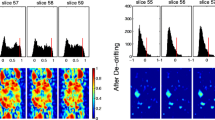Abstract
We propose to detect brain activation from fMR time-series of a group study by modeling fuzzy features. Five discriminating features are automatically extracted from fMRI data by a sequence of temporal-sliding-windows. A fuzzy model based on these features is first derived by a gradient method on a set of initial training data and then incrementally enhanced. The resulting fuzzy activation maps of all subjects are then combined to provide a measure of strength of activation of each voxel, based on the group of subjects. A two-way thresholding scheme is introduced to determine true activated voxels. The method is tested on both synthetic and real fMRI datasets. The method is less vulnerable to correlated noise and able to capture the key activation from a group of subjects by adapting to hemodynamic variability across subjects.







Similar content being viewed by others
References
Andersen AH, Gash DM, Avison MJ (1999) Principal component analysis of the dynamic response measured by fMRI. Magn Reson Imaging 17(6):795–815
Benjamini Y, Hochberg Y (1995) Controlling the false discovery rate: a practical and powerful approach to multiple testing. J R Stat Soc Ser B 57:289–300
Bullmore E, Long C, Fadili J, Calvert G, Zalaya F, Carpenter TA, Brammer M (2001) Colored noise and computational inference in neuophysiological (fMRI) time series analysis: resampling methods in time and wavelet domains. Hum Brain Mapp 12:61–78
Biswal B, Ulmer J (1999) Blind source separation of multiple signal sources of fMRI data sets using independent component analysis. J Comput Assist Tomogr 23(2):265–271
Chuang K, Chiu M, Lin C, Chen J (1999) Model-free functional MRI analysis using Kohonen clustering neural network and fuzzy c-means. IEEE Trans Med Imaging 18:1117–1128
Friston KJ, Holmes AP, Worsley KJ, Poline J-B, Frith CD, Frackowiak RSJ (1995) Statistical parametric maps in functional imaging: a general linear approach. Hum Brain Mapp 2:189–210
Hossein-Zadeh GA, Soltanian-Zadeh H, Ardekani BA (2003) Multiresolution fMRI activation detection using translation invariant wavelet transform and statistical analysis based on resampling. IEEE Trans Med Imaging 22(3):302–314
Lu W, Rajapakse JC (2005) Approach and applications of constrained ICA. IEEE Trans Neural Netw 16(1):203–212
Lu W, Rajapakse JC (2006) ICA with reference. Neurocomputing 69:2244–2257
Mechelli A, Friston KJ, Price CJ (2000) The effects of presentation rate during word and pseudoword read: a Comparison of PET and fMRI. Cogn Neurosci 12:145–156
McKeown MJ, Makeig S, Brown GG, Jung TP, Kindermann SS, Bell AJ, Sejnowski TJ (1998) Analysis of fMRI data by blind separation into independent spatial components. Hum Brain Mapp 6:160–188
Meyer-Baese A, Wismueller A, Lange O (2004) Comparison of two exploratory data analysis methods for fMRI: unsupervised clustering versus independent component analysis. IEEE trans Info Technol Biomed pp 387–398
Ngan S, Hu X (1999) Analysis of functional magnetic resonance imaging data using self-organizing mapping with spatial connectivity. Mgn Reson Med 41:939–946
Ogawa S, Tank D, Menon R (1992) Intrinsic signal changes accompanying sensory simulation: Functional brain mapping with magnetic resonance imaging. Proc Natl Acad Sci 89:5951–5955
Ross TJ (2004) Fuzzy logic with engineering applications, 2nd edn. Wiley, London, pp 213–241
Rajapakse JC, DeCarli C, Mclaughlin A, Giedd JN, Krain AL, Hamburger SD, Rapoport JL (1996) Cerebral magnetic resonance image segmentation using data fusion. J Comput Assist Tomogr 20(2):206–218
Rajapakse JC, Giedd JN, DeCarli C, Snell JW, McLaughlin A, Vauss YC, Krain AL, Hamburger S, Rapoport JL (1996) A technique for single-channel MR brain tissue segmentation: application to a pediatric sample. Magn Reson Imaging 14(9):1053–1065
Rajapakse JC, Kruggel F, Maisog JM, von Cramon DY (1998) Modeling hemodynamic response for analysis of functional MRI time-series. Hum Brain Mapp 6:283–300
Rajapakse JC, Piyaratna J (2001) Bayesian approach to segmentation of statistical parametric maps. IEEE Trans Biomed Eng 48:1186–1194
Welcome Department of Imaging Neuroscience, Statistical Parametric Mapping, http://www.fil.ion.ucl.ac.uk/spm/, 2004
Vazquez AL, Noll DC (1998) Nonlinear aspects of the bold response in functional mri. Hum Brain Mapp 40:249–260
Woolrich MW, Jenkinson M, Brady JM, Smith SM (2004) Fully Bayesian spatio-temporal modeling of fMRI data. IEEE Trans Med Imaging 24(2):213–231
Worsley KJ, S.Marrett, Neelin P, Vandal AC, Friston KJ, Evans AC (1996) A united statistical approach for determining significant signals in images of cerebral activation. Hum Brain Mapp 4:58–73
Wang Y, Rajapakse JC (2006) Contextual modeling of functional MR images with conditional random fields. IEEE Trans Med Imaging 25(6):804–812
Zheng X, Rajapakse JC (2006) Learning functional structure from fMR images. Neuroimage 31(4):1601–1613
Zhou J, Rajapakse JC (2006) Extraction of fuzzy features for detecting brain activation from functional MR time-series, neural information processing. Lecture Notes on Computer Science 4243:983–992
Zhou J, Rajapakse JC (2005) Segmentation of subcortical brain structures using fuzzy templates. Neuroimage 28(4):927–936
Author information
Authors and Affiliations
Corresponding author
Rights and permissions
About this article
Cite this article
Zhou, J., Rajapakse, J.C. Modeling hemodynamic variability with fuzzy features for detecting brain activation from fMR time-series. Neural Comput & Applic 16, 541–549 (2007). https://doi.org/10.1007/s00521-007-0103-0
Received:
Accepted:
Published:
Issue Date:
DOI: https://doi.org/10.1007/s00521-007-0103-0




